Did you know that the direction in which buttonhole stitch is stitched makes a difference in the finished look of the buttonhole stitch? You almost wouldn’t think it would – buttonhole stitch, after all, is buttonhole stitch.
There are two points that come to mind when speaking about stitch direction and buttonhole stitch: The downward stroke of the stitch, and the twisted rope-like edge that forms on the outside edge of the stitch.
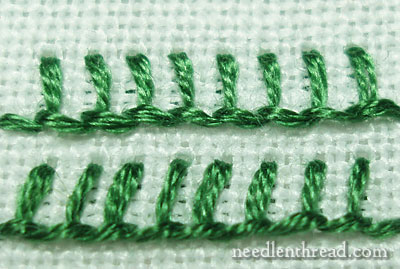
In the photo above, you can see two rows of spaced buttonhole stitch, the top row worked from left to right, and the bottom row from right to left. Now, the shift of the vertical stroke in the stitch can be controlled a little bit with tension, and when working the stitch close together (for an edging or a solid, thick line) it’s much easier to keep the stitches looking vertical and parallel. When the stitches are worked farther apart, the pull from the corner of the stitch tends to slightly shift the vertical stroke of the stitch.
BUT – that’s not the part that I really wanted to write about today. I’ve noticed that sometimes beginners, when learning buttonhole stitch, assume that it doesn’t really matter in which direction the stitch is worked. However, in a piece of needlework that involves a lot of buttonhole stitch, it’s important to keep the stitch consistent. Working rows of buttonhole from left to right (which is the normal direction when using an s-twisted thread) and then switching and working from right to left changes the look of the stitch – most notably because of the direction of the twist of the stitch on the edge, as demonstrated in the diagram below:
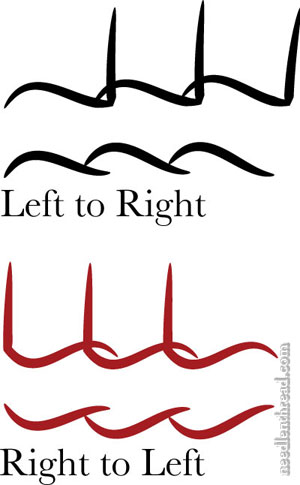
This point comes back to the difference between s-twisted and z-twisted embroidery threads. The s-twisted thread looks best when stitched from left to right. The z-twisted thread looks best when stitched from right to left.
With cotton – whether perle or stranded – I’ve not found that much of a difference in the actual ease of making the stitch from one direction or the other. But with z-twisted threads (rayons and various silks), I’ve always found it more difficult to make the buttonhole stitch in the more natural direction for a right-handed stitcher (which would be from left to right). The thread twists up on itself and becomes cranky! Also, the z-twisted thread, worked from left to right, does not make as attractive an edge on the buttonhole stitch. The rope-like overlapping of the stitches twists together too much.
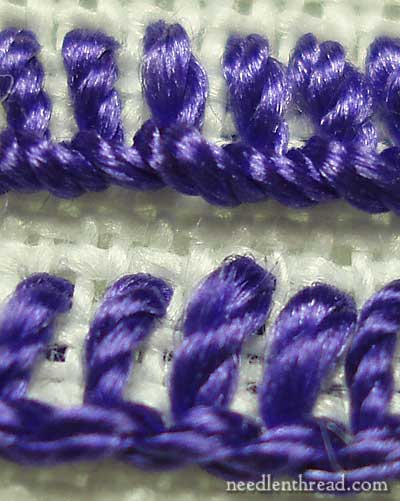
(Apologies for the poor photo!) The top line is a z-twisted silk, worked from left to right. See how tight the twist is kept in the stitch? The characteristic wavy overlapping of the stitches is not so easily discernible. The lower line of stitches is the same z-twisted silk, worked right to left. Though the lower line in the photo is a bit blurry, you can see that the stitches keep their overlapping definition better on the lower row of stitches.
If you take a look at a row of stem stitch (stitched from left to right with cotton thread)…
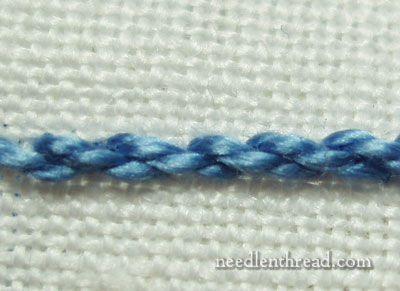
… and you take a look at a row of buttonhole stitch (stitched from left to right with cotton thread)…
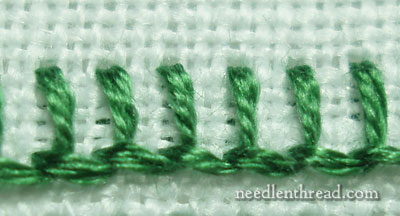
… what do you notice? See the edge on the buttonhole stitch? It looks a lot like that line of stem stitch – and the twist in the stitch is the same. So everything that’s true about stem stitch stitched from left to right or from right to left with either s-twisted or z-twisted threads, applies as well to the buttonhole stitch. If you’d like to read about stem stitch direction with s-twisted or z-twisted threads, it will help demonstrate why it’s important to consider stitch direction when working the buttonhole stitch!
I know it can get confusing when I go on about left-to-right, right-to-left, z-twist, s-twist, and so forth! But don’t you think it’s interesting how the twist of the thread in manufacturing really does make a difference in the look of a stitch?
Have a terrific Tuesday!







As a lefty I have trouble with a lot of them (did I make a stem stitch or an outline stitch?)and most of the time I just turn my work upside down and go at it! Any suggestions for things to help lefties? I have an off the topic question too… What is your fav embroidery book that you would want with you on a deserted island and what one are you still searching for that would be the icing on you library?
Mary, when you make the buttonhole stitch in a circle for a flower etc., it starts to turn down into the centre rather than lying nice and flat, what is the secret to making this stitch.
I feel like my husband must have felt when, three years into our marriage and thirty-five years into our life, I pointed out that if you tie your shoes by wrapping around the wrong loop, you make a granny knot. And he was just shy of Eagle Scout when he went off to college.
And now here I am, finally figuring out why my stitching sometimes looks “off.” I’m glad it took me this long to learn about how much the direction of stitch matters. I took to embroidery because, as a lefty, it was easier to mimic my mother than knitting or crocheting. Now that I know what I’m doing, I won’t mind getting persnickety about it. I wonder, though, if lefties gravitate toward rayon and silk–once I’ve relaxed the fibers, I think rayon is dreamy. Maybe it’s just because I prefer to go from right to left when I stitch.
Very interesting… I’d never thought about how important the direction sitched was.. Thanks, Mary
This is important when you are working detached buttonhole stitch as well. If you work all of your DBH rows left to right, the stitches will all slant in the same direction. If you work the first row of DBH left to right and then work the next row on the return right to left, the slant of your stitches will alternate as well.
Thanks for an illuminating post. I’ve done a lot of buttonhole stitching doing Hardanger embroidery and, while I’d noticed a difference between directions, I’d never thought it through or figured out exactly what was going on. I have to be careful because I’m comfortable doing buttonhole in either direction.
Isn’t that a blanket stitch?
Mary, Thanks for pointing out this fine detail. It does matter which way the thread is crimped or twisted. I see it in a bigger picture of how all things work with their own nature, not as well going against it. Even a Tee-shirt in a washing machine turns itself inside out, because that is the way it was originally made! Comes the adage “Go with the flow”!
This is slightly off subject, but have you figured out the way to join up buttonhole stitch on an edge? I’ve tried to figure it out to no avail.
More valuable information Mary – thank you! I never would have realized that the twist of the thread would make that much difference.
Brilliant post and photographs. I am glad that you have pointed out s and z to so many people. I enjoy checking needle lace to see if the stitching was done towards the body or away. Amazing what can “read” from blanket stitch.
Thank you for the very detailed explanations and photos.
Hi, All! Thanks for your comments! I’ll try to answer a few questions:
For lefties (and for right-handers) consider working the stitch towards you or away from you, rather than horizontally…. To keep the direction straight, picture in your mind working from left to right, and then turn your work accordingly.
Kathy – Blanket stitch vs buttonhole stitch – well, technically, yes, this is also a blanket stitch (they are pretty much synonymous), but it is also called buttonhole stitch. The other form of buttonhole stitch (which is the more technical “buttonhole stitch”) is referred to as the “tailor’s buttonhole” specifically. In general, in any stitch books and stitching directions on the market today, when you see “buttonhole stitch” diagramed, described, or explained, they’re talking about this stitch.
Cynthia – I’m not sure I get what you’re asking about joining buttonhole on the edge? Can you elaborate? You can also e-mail me if you want!
Thanks again for the comments!
MC
Hi Mary,
Thank you for your explanation and photos,I found this very interesting.
Joan.
I suppose this is why on some old wooden thread of buttonhole twist ‘left twist’ is specified…thank you for denoting the difference